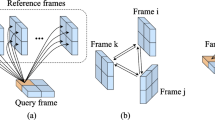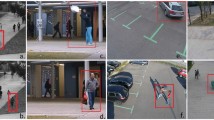Abstract
An efficient video shot boundary detection is highly desirable for subsequent semantic video content analysis and retrieval applications. The major challenge of shot boundary detection problem is an appropriate choice of features to handle the illumination variation and motion artifacts of frames while finding the boundary in a shot. In this paper, to improve the efficacy of shot boundary detection in presence of the aforementioned challenges, the strength of the gradient feature is explored to develop a dual detection framework for automatic shot boundary detection. In the first phase, abrupt transition (AT) detection is addressed in presence of illumination variation and motion in the frames of a shot by generating an combined feature through joint histogram of gradient magnitude and gradient orientation features frame. In the second phase, gradual transition detection (GT) detection is applied only on the frames within two AT frames satisfying specific frame distance criteria. Handling both AT and GT by the proposed simple gradient-based framework is the uniqueness of this work. Moreover, the proposed method is fully ubiquitous, independent of the video content and free from any training process. Exhaustive simulations are carried out on different databases to validate the proposed approach. The performance of the proposed feature-based shot boundary framework, in terms of average F1 measure, is 94% for AT detection, 84% for GT detection and 90.01% for overall detection.







Similar content being viewed by others
References
Abdulhussain SH, Ramli AR, Saripan MI, Mahmmod BM, Al-Haddad SAR, Jassim WA (2018) Methods and challenges in shot boundary detection: a review. Entropy vol 20(4)
Birinci M, Kiranyaz S (2014) A perceptual scheme for fully automatic video shot boundary detection. Signal Process Image Commun 29(3):410–423
Chakraborty D, Chiracharit K, Chamnongthai W (2021) Video shot boundary detection using principal component analysis (pca) and deep learning. 2021 18th International conference on electrical engineering electronics, computer, telecommunications and information technology (ECTI-CON), pp 272–275 doi=,
Chakraborty S, Singh A, Thounaojam DM (2022) A novel bifold-stage shot boundary detection algorithm: invariant to motion and illumination. Vis Comput 38:445–456
Chakraborty S, Thounaojam DM (2020) Sbd-duo: a dual stage shot boundary detection technique robust to motion and illumination effect. Multimed Tools Appl 80(2):3071–3087
Chakraborty S, Thounaojam DM, Sinha N (2021) A shot boundary detection technique based on visual colour information. Multimed Tools Appl 80 (3):4007–4022
Chasanis VT, Likas AC, Galatsanos NP (2009) Scene detection in videos using shot clustering and sequence alignment. IEEE Trans Multimed 11 (1):89–100
Cotsaces C, Nikolaidis N, Pitas I (2006) Video shot detection and condensed representation.a review. IEEE Signal Proc Mag 23(2):28–37
Dalal N, Triggs B (2005) Histograms of oriented gradients for human detection. 2005 IEEE Comput Society Conf Comput Vis Pattern Recognit (CVPR’05) 1:886–893
Dhiman S, Chawla R, Gupta S (2019) A novel video shot boundary detection framework employing dct and pattern matching. Multimed Tools Appl 78 (24):34707–34723
Fan J, Zhou S, Siddique MA (2017) Fuzzy color distribution chart -based shot boundary detection. Multimed Tools Appl 76(7):10169–10190
Giveki D, Soltanshahi MA, Montazer GA (2017) A new image feature descriptor for content based image retrieval using scale invariant feature transform and local derivative pattern. Optik - Int J Light Electron Optics 131:242–254
Gygli M (2018) Ridiculously fast shot boundary detection with fullyconvolutional neural networks. In: International conference on content-based multimedia indexing, CBMI 2018, La Rochelle, France, https://doi.org/10.1109/CBMI.2018.8516556, pp 1–4, 4–6 September
Hanjalic A (2002) Shot boundary detection: unraveled and resolved. IEEE Trans Circuits Syst Video Technol 12(2):90–105
Hassanien A, Elgharib M, Bae SH, Hefeeda M, Matusik W (2017) Large-scale, fast and accurate shot boundary detection through spatio-temporal convolutional neural networks. arXiv:1705.03281
Huang M, Shu H, Ma Y, Gong Q (2015) Content-based image retrieval technology using multi-feature fusion. Optik - Int J Light and Electron Optics 126(19):2144–2148
Jian M, Lam K, Dong J, Shen L (2015) Visual-patch-attention-aware saliency detection. IEEE Trans Cybern 45(08):1575–1586
Jian M, Qi Q, Dong J, Yin Y, Lam K-M (2018) Integrating qdwd with pattern distinctness and local contrast for underwater saliency detection. J Vis Commun Image Represent 53:31–41
Jian M, Wang J, Dong J, Cui C, Nie X, Yin Y (2020) Saliency detection using multiple low-level priors and a propagation mechanism. Multimed Tools Appl 79:33467–33482
Jian M, Zhang W, Yu H, Cui C, Nie X, Zhang H, Yin Y (2018) Saliency detection based on directional patches extraction and principal local color contrast. J Vis Commun Image Represent 57:1–11
Jiang X, Sun T, Liu J, Chao J, Zhang W (2013) An adaptive video shot segmentation scheme based on dual-detection model. Neurocomputing 116:102–111
Kar T, Kanungo P (2015) A texture based method for scene change detection. In: 2015 IEEE power communication and information technology conference (PCITC), pp 72–77, 15–17
Kavitha J, Jansi Rani PA, Sowmyayani S (2017) Wavelet-based feature vector for shot boundary detection. Int J Image Graph 17(01):1750002
Koprinska I, Carrato S (2001) Temporal video segmentation: a survey. Signal Process Image Commun 16(5):477–500
Lakshmi Priya GG, Domnic S (2014) Walsh-hadamard transform kernel-based feature vector for shot boundary detection. IEEE Trans Image Process 23 (12):5187–5197
Liang R, Zhu Q, Wei H, Liao S (2017) A video shot boundary detection approach based on cnn feature
Lu Z, Shi Y (2013) Fast video shot boundary detection based on svd and pattern matching. IEEE Trans Image Process 22(12):5136–5145
Mohanta PP, Saha SK, Chanda B (2012) A model-based shot boundary detection technique using frame transition parameters. IEEE Trans Multimed 14 (1):223–233
Montazer GA, Giveki D (2015) Content based image retrieval system using clustered scale invariant feature transforms. Optik - Int J Light Electron Optics 126(18):1695–1699
Rashmi BS, Nagendraswamy HS (2021) Video shot boundary detection using block based cumulative approach. Multimed Tools Appl 80(1):641–664
Sampath Dakshina Murthy A, Karthikeyan T, Vinoth Kanna R (2021) Gait-based person fall prediction using deep learning approach. Soft Comput
Sampath Dakshina Murthy A, Karthikeyan T, B et al, Jagan OL (2020) Novel deep neural network for individual re recognizing physically disabled individuals. Materials Today: Proc:4323
Sasithradevi A, Roomi MM (2020) A new pyramidal opponent color-shape model based video shot boundary detection. J Vis Commun Image Represent, vol 67(C)
Sasithradevi A, Roomi S, Maheesha M (2018) Shot boundary detection in videos using saliency based statistical model. In: In proceedings of the 11th indian conference on computer vision, graphics and image processing
Singh A, Thounaojam DM, Chakraborty S (2020) A novel automatic shot boundary detection algorithm: robust to illumination and motion effect. SIViP 14:645–653
Soucek T, Moravec J, Lokoc J (2019) Transnet: a deep network for fast detection of common shot transitions arxiv:1906.03363v1[cs.CV]
Tippaya S, Sitjongsataporn S, Tan T, Khan MM, Chamnongthai K (2017) Multimodal visual feature based video shot boundary detection. Image Process IEEE Access:12563–12575
Video dataset http://www.open-video.org. Accessed 10 May 2015
Warhade KK, Merchant SN, Desai UB (2011) Shot boundary detection in presence of fire flicker and explosion using stationary wavelet transform. Signal Image Video Process 5(4):507–515
Wu X, Qi Y et al, Zhou S (2021) Video shot boundary detection based on multi-level features collaboration. SIViP 15(3):627–635
Yoo HW, Ryoo HJ, Jang DS (2006) Gradual shot boundary detection using localised edge blocks. Multimed Tools Appl 28(3):283–300
Youssef B, Fedwa E, Driss A, Ahmed S (2017) Shot boundary detection via adaptive low rank and svd-updating. Comput Vis Image Understand 161:20–28
Acknowledgements
The Sound and Vision video used in this work is provided solely for research purposes through the TREC Video Information Retrieval Evaluation Project Collection.
Author information
Authors and Affiliations
Corresponding author
Ethics declarations
Conflict of Interests
The authors have no relevant financial or non-financial interests to disclose. The authors have no conflicts of interest to declare that are relevant to the content of this article. All authors certify that they have no affiliations with or involvement in any organization or entity with any financial interest or non-financial interest in the subject matter or materials discussed in this manuscript. The authors have no financial or proprietary interests in any material discussed in this article.
Additional information
Publisher’s note
Springer Nature remains neutral with regard to jurisdictional claims in published maps and institutional affiliations.
Rights and permissions
About this article
Cite this article
Kar, T., Kanungo, P. A gradient based dual detection model for shot boundary detection. Multimed Tools Appl 82, 8489–8506 (2023). https://doi.org/10.1007/s11042-022-13547-y
Received:
Revised:
Accepted:
Published:
Issue Date:
DOI: https://doi.org/10.1007/s11042-022-13547-y




